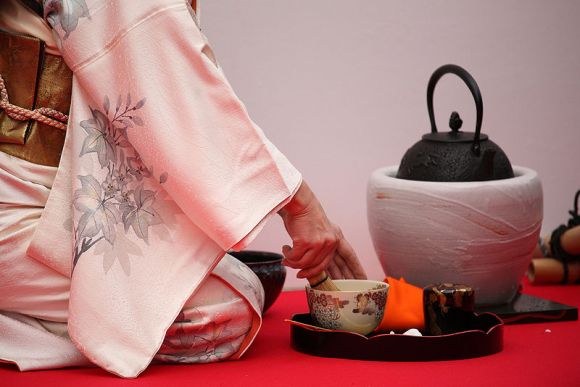
The culture of tea in Japan goes back one thousand years. Today, we’re going to scratch the surface with this short introduction to the wonders of the Japanese tea ceremony.
In the U.K. they serve high tea. In Australia, they serve morning tea and afternoon tea. In Japan, they have chado, literally “the Way of Tea.” In the U.S., in contrast to the Way of Tea, we had the Bay of Tea, dumping vast quantities of it into the harbor to protest England’s tax on tea. You haven’t been able to get a good cuppa in the U.S. since.
▼ Tea Ceremony in Japan
▼A tea party in America in 1773.

But Japan tops us all when it comes to tea and tea parties. Japanese tea ceremony is an art form that has been perfected over a thousand years. Japanese tea masters dedicate their lives to the ritual preparation of a simple bowl of tea.
In Japan the tea ceremony can be a half-day affair, lasting up to four hours—if you’re prone to spending long periods of time at the library without actually reading any books, this may be just the activity for you! Indeed, there are literally thousands of books on the Japanese ritual of tea, none of which you will probably ever read.
Origins of Chanoyu
The tea ceremony, (called chanoyu, or chado if you prefer, or even sado if you insist) was brought to Japan from China along with myriad other Chinese culture that was crammed onto a cargo boat. It’s incredible when you think about all the stuff the Japanese brought back with them from China: kanji, calligraphy and the tea ceremony being just a paltry few. I imagine Japanese Buddhist priests such as Eichu and Kukai (after having imported Buddhism) walking through the vast country of China and pointing to various things: “We’ll have some of that Shingon Buddhism, and a bit of the Bodhidarma, and by the way, give us some of that tea ceremony with a bit of calligraphy on the side!” Only after the tiny boat was full did they claim, “Anchors away!” and bring all their plunder here to Japan. In fact, Japan was the world’s first China Town. But since there were hardly any Chinese people in this country, they just called it Japan.
Even the “Seven Lucky Gods” came to Japan from China. They managed to all fit on a tiny vessel called the takarabune, destined for the 800-km journey which we presume terminated at the port of Nagasaki.
▼ The takarabune treasure boat carrying the Seven Lucky Gods, proves that a lot of Chinese culture could be loaded onto just one small boat.
The Japanese tea ceremony eventually developed into its own version, a four-hour event of absolute propriety, performed while wearing a traditional kimono and kneeling seiza style. You see, this is not your grandmother’s cup of tea (unless your grandmother is Japanese, in which she probably used the tea ceremony as a form of strict childhood discipline). It’s impressive that the interminable ceremony has endured to this day, despite this proclaimed age of instant gratification. There is not even a tea ceremony app.
But luckily, we now have a shorter Way of Tea. The abbreviated version came about, no doubt, because just having a cup of tea in the morning was enough to prevent people from getting to work before noon. So, just like the game of cricket, which used to play week-long tournaments but had to shorten the game in order to retain its fan base (sometimes people died before the end of a tournament), the tea ceremony now has a more casual and endurable version for those who don’t want to risk losing their lower limbs by sitting for long periods of time seiza style.
▼Japanese powdered green tea is called matcha.
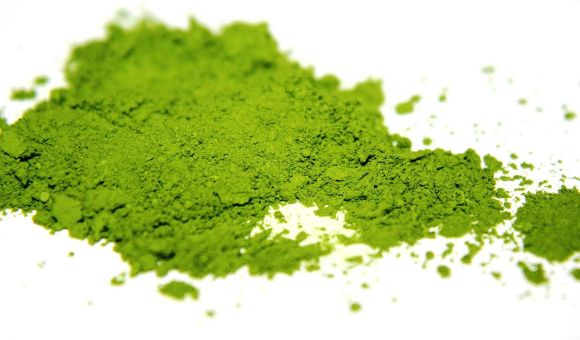
These shorter tea ceremonies, called chakai, are a good introduction into the world of matcha, Japanese powdered green tea. If after this abridged version, your legs have survived the pins and needles and are still very much attached to the body, then by all means, try to sever them completely in the four-hour rendition. Try to go for one that includes a high-class kaiseki ryori meal. Good food is known to make leg pain more endurable.
Tea Houses
Japanese tea houses historically populated the archipelago along pilgrimage routes such as the Tokaido, Basho’s Narrow Road to the Deep North and the Kumano Kodo where travelers would stop to rest and have a cuppa.
▼ “The morning after a snowfall” by Katsushika Hokusai shows the tea house at Koishikawa from Thirty-six views of Mount Fuji.
▼ The (reconstructed) remains of the “Sakurachaya” tea house along the Kumano Kodo. The owners of the tea house would look out to the other side of the valley for pilgrims coming over the mountain then start preparing tea and mochi for their arrival.
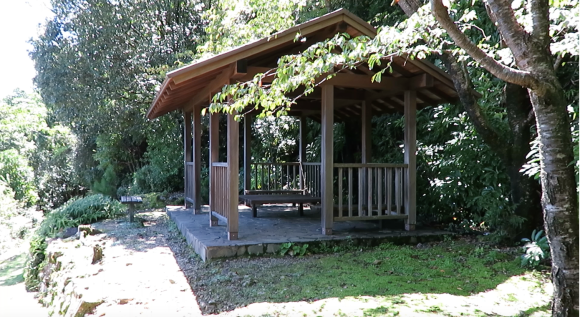
Needless to say, with the modern-day pit stops such as Starbucks, the experience of stopping for a cup of tea along the road has changed quite a bit.
Let’s look at exactly what is involved in Japanese tea ceremony. In an overt act to discipline the masses, the tea ceremony reminds us to be mindful of others, appreciative of nature, and to put our hosts above everything else. Silence and quiet talking are valued (no gossiping or complaining about work), as well as appreciation of the intricate tools used, the proscribed ceremony procedures and the value of sharing a cup of thick green liquid among friends.
Private Tea Houses
You’ll need a tea house or at least a special tea room to take part in a tea ceremony (although some are performed outside). Many of Japan’s famous gardens (the ones you have to pay to get into) have traditional Japanese tea houses and they will offer tea ceremony experiences on certain days of the year.
▼ Japanese tea houses are usually made of natural materials on order to appreciate the blessings of nature.
Inside the tea house
The tea room will contain a tokonoma in which will to display a calligraphy scroll and a flower arrangement. This one also displays an incense burner. The floor is traditional tatami mats which can be knelt on for the event.
Tools for making tea
There are many special tools (hundreds, actually) for making Japanese tea but here are some of the basics: A lacquered storage container for holding the green tea powder, ceramic tea bowls, and a bamboo whisk. Ceramics are specially selected according to their personality and aesthetics.
▼ Pictured: Not a gantleman’s shaving kit
▼ Chaki, storage container for powdered matcha tea.
Tea Master
Of course, a tea ceremony cannot be held without a host. True tea masters dedicate their lives to perfecting each aspect of the tea ceremony, imbuing it with meaning and purpose. Monks are often trained in the art, and many of Japan’s most famous tea masters have been Buddhist monks. So you can rest easy that no matter what may happen in the world, there will be one monk who will calmly call everyone together for a sober bowl of tea before panicking.
One of Japan’s famous tea masters and Zen priests, Ikkyu Sojun (1394-1481) imbuing meaning and purpose.

The most recent tea ceremony I attended was surely one that would make the Guinness Book of World Records for most ephemeral tea ceremony in Japan. I attended the spring Miyako Odori geisha show in Kyoto. This traditional performance included a tea ceremony with a maiko (apprentice geisha) before the show. Wow, count me in!
▼A maiko prepares for a tea ceremony in Gion, Kyoto.
When I arrived at the theater in Gion, I entered the waiting room with one hundred other people, all Japanese. The lady sitting next to me told me she lived in Kyoto and came to the spring show every year. I felt lucky to be taking part in something so Japanese, something not merely put on for foreign tourists.
Once we were let into the tea ceremony room, which was big enough to hold ballroom dances, we were directed to long low tables with zabuton cushions next to them to kneel on, the faithful filing into each rank as if being ushered into rows of church pews. Each place setting had a Japanese sweet. Women in kimono hurried around filling tea bowls.
▼Japanese sweets are served to balance the bitterness of the green tea.
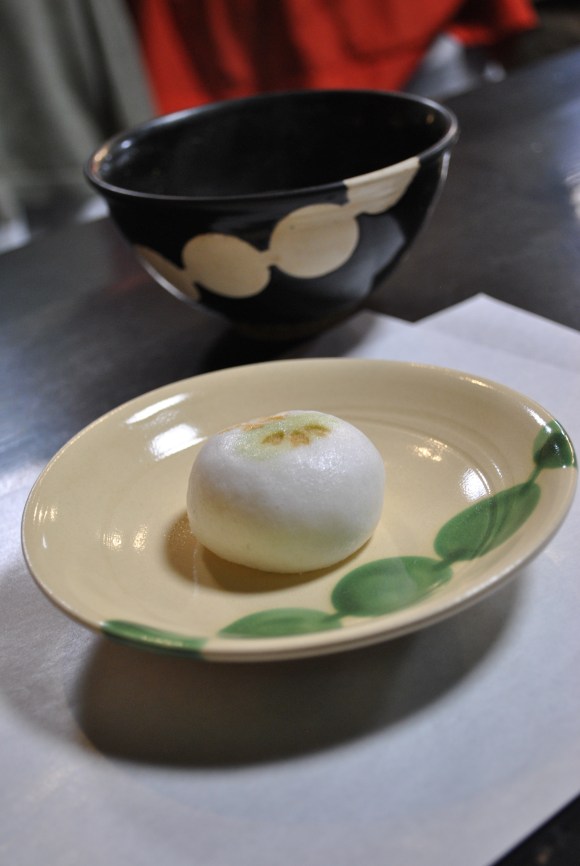
I took a few photos of the green sweets and the tea…
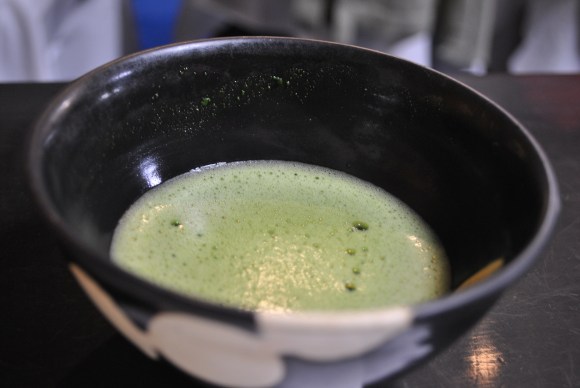
…and when I looked up, the entire room had already finished their tea and was being herded into the performance hall. I was shocked to experience a five-minute tea ceremony. That was one whirlwind appreciation of nature, serenity and spiritual depth!
I was expecting more of something out of Matsuo Basho haiku:
A monk sips morning tea,
it’s quiet,
the chrysanthemum is flowering.
But all I heard was the clanking of tea bowls being cleared. When I stood to get up, with no one standing or sitting in front of me now, for the first time I was able to see where the geiko (geisha) had, formerly, been making tea at the front of the room with the assistance of a maiko. But they had both already disappeared.
We were told to keep the plates the sweets had come on, probably to appease the organizer’s pangs of guilt. I felt sorry for these plates, made and painted for the sole purpose of a meaningful existence at a tea ceremony, where they would be admired and stroked, their colors complementing the season and their very character elevated to that of fine bone china. The harsh reality for these plates was that they had finished their purposeful life after just five minutes. They’ll probably never see a tea ceremony again.
It just goes to show that beauty is fleeting. And that a five-minute tea ceremony demands an app.

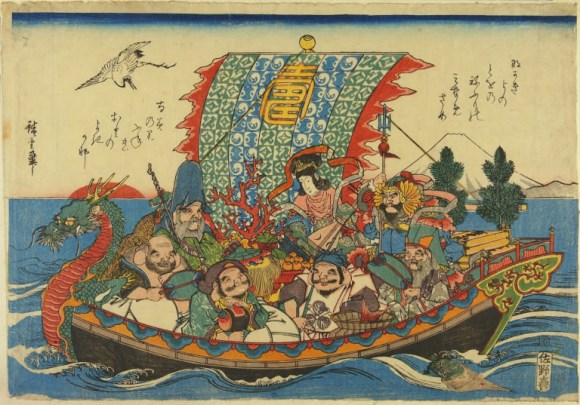
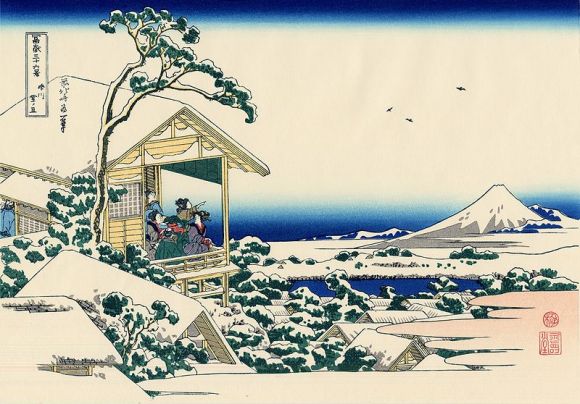
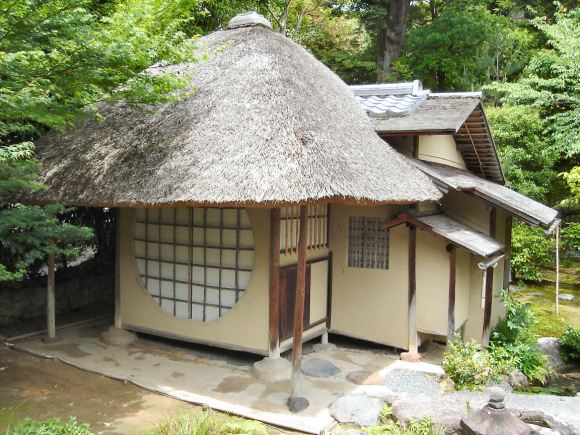

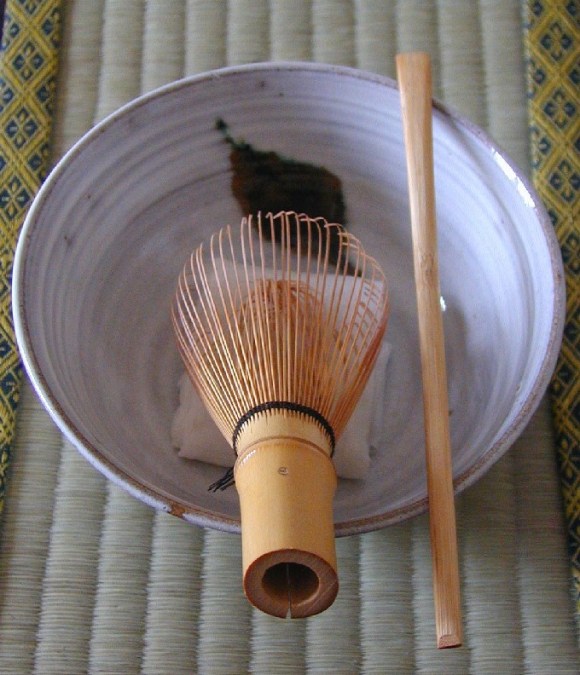
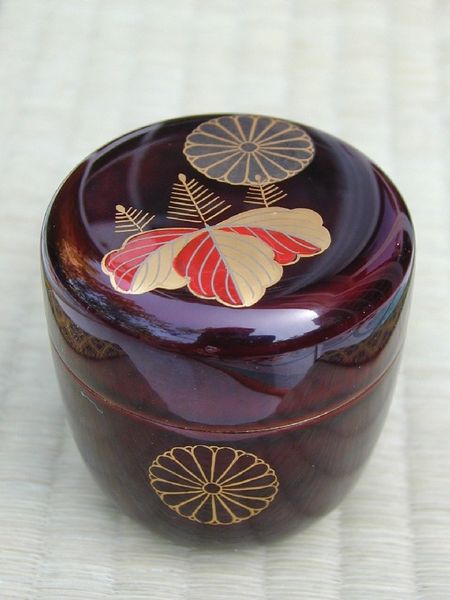
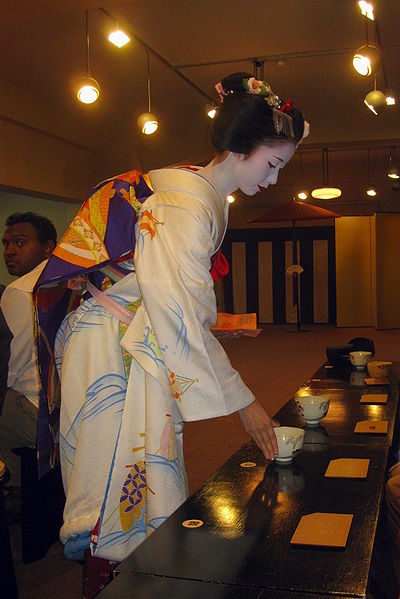
 Robot performs traditional Japanese tea ceremony, serves up frothy matcha in seconds 【Video】
Robot performs traditional Japanese tea ceremony, serves up frothy matcha in seconds 【Video】 Enjoy a Japanese tea ceremony in a traditional storehouse
Enjoy a Japanese tea ceremony in a traditional storehouse Enjoy fine Japanese tea selections and more at Bangkok’s best new teahouse
Enjoy fine Japanese tea selections and more at Bangkok’s best new teahouse LED tatami floors take us to the tea ceremony of the future
LED tatami floors take us to the tea ceremony of the future One Piece anime character now appears as Japanese wagashi tea ceremony sweet
One Piece anime character now appears as Japanese wagashi tea ceremony sweet We found possibly the quietest Japanese-style hotel in Tokyo’s bustling Shinjuku district
We found possibly the quietest Japanese-style hotel in Tokyo’s bustling Shinjuku district Studio Ghibli releases new anime calendars for 2026 with heartwarming fan service
Studio Ghibli releases new anime calendars for 2026 with heartwarming fan service Chocolate-covered shrimp snacks make a comeback in Japan this winter
Chocolate-covered shrimp snacks make a comeback in Japan this winter 7 great places to see Mt. Fuji from without having to climb it
7 great places to see Mt. Fuji from without having to climb it How much difference does the choice of mold make in fermenting food?
How much difference does the choice of mold make in fermenting food? Japan’s oldest largetooth sawfish in captivity back on display in Mie Prefecture
Japan’s oldest largetooth sawfish in captivity back on display in Mie Prefecture Muji cake mania! Which of the 23 flavors of cake they sell are the best?
Muji cake mania! Which of the 23 flavors of cake they sell are the best? This French toast recipe that uses ice cream will knock your pajamas off【SoraKitchen】
This French toast recipe that uses ice cream will knock your pajamas off【SoraKitchen】 Eight Ways You Really, Really Shouldn’t Use a Japanese Toilet
Eight Ways You Really, Really Shouldn’t Use a Japanese Toilet Starbucks Japan unveils new Sakura Frappuccino for cherry blossom season 2025
Starbucks Japan unveils new Sakura Frappuccino for cherry blossom season 2025 Starbucks Japan ready to get Year of the Horse started with adorable drinkware and plushies【Pics】
Starbucks Japan ready to get Year of the Horse started with adorable drinkware and plushies【Pics】 7-Eleven Japan’s ramen-cooking robot whipped us up a bowl of noodles【Taste test】
7-Eleven Japan’s ramen-cooking robot whipped us up a bowl of noodles【Taste test】 Lacquerware supplier to emperor of Japan and Pokémon team up for new tableware
Lacquerware supplier to emperor of Japan and Pokémon team up for new tableware Cyberpunk anime meets traditional culture in Ghost in the Shell gold leaf Japanese changing screens
Cyberpunk anime meets traditional culture in Ghost in the Shell gold leaf Japanese changing screens Japan may add Japanese language proficiency, lifestyle classes to permanent foreign resident requirements
Japan may add Japanese language proficiency, lifestyle classes to permanent foreign resident requirements Hello Kitty Choco Egg figures are an adorable trip through three periods of Japanese pop culture【Pics】
Hello Kitty Choco Egg figures are an adorable trip through three periods of Japanese pop culture【Pics】 Japan’s otoshidama tradition of giving kids money at New Year’s gets a social welfare upgrade
Japan’s otoshidama tradition of giving kids money at New Year’s gets a social welfare upgrade Starbucks Japan releases new zodiac chilled cup drink for 2026
Starbucks Japan releases new zodiac chilled cup drink for 2026 Can a dirty butthole make you filthy rich in Japan? We’re starting a New Year’s lottery experiment
Can a dirty butthole make you filthy rich in Japan? We’re starting a New Year’s lottery experiment 7-Eleven Japan starts new temporary luggage storage service in over 300 branches
7-Eleven Japan starts new temporary luggage storage service in over 300 branches Disillusionment at Tsukiji’s tourist-target prices led us to a great ramen restaurant in Tokyo
Disillusionment at Tsukiji’s tourist-target prices led us to a great ramen restaurant in Tokyo Starbucks teams up with 166-year-old Kyoto doll maker for Year of the Horse decorations【Photos】
Starbucks teams up with 166-year-old Kyoto doll maker for Year of the Horse decorations【Photos】 Tokyo considering law requiring more trash cans following litter increase in heavily touristed area
Tokyo considering law requiring more trash cans following litter increase in heavily touristed area Tokyo’s Tsukiji sushi neighborhood asks tour groups to stay away for the rest of the month
Tokyo’s Tsukiji sushi neighborhood asks tour groups to stay away for the rest of the month Nintendo’s Kirby now delivering orders at Kura Sushi restaurants, but not in Japan
Nintendo’s Kirby now delivering orders at Kura Sushi restaurants, but not in Japan Tokyo event lets you travel back in time, for free, to celebrate 100 years since Showa era start
Tokyo event lets you travel back in time, for free, to celebrate 100 years since Showa era start Sanrio theme park in Japan announces plans to expand into a Sanrio resort
Sanrio theme park in Japan announces plans to expand into a Sanrio resort Stamina-destroying “Paralysis Noodles” are Tokyo’s newest over-the-top ramen innovation
Stamina-destroying “Paralysis Noodles” are Tokyo’s newest over-the-top ramen innovation Survey asks foreign tourists what bothered them in Japan, more than half gave same answer
Survey asks foreign tourists what bothered them in Japan, more than half gave same answer Japan’s human washing machines will go on sale to general public, demos to be held in Tokyo
Japan’s human washing machines will go on sale to general public, demos to be held in Tokyo Japan’s deadliest food claims more victims, but why do people keep eating it for New Year’s?
Japan’s deadliest food claims more victims, but why do people keep eating it for New Year’s? We deeply regret going into this tunnel on our walk in the mountains of Japan
We deeply regret going into this tunnel on our walk in the mountains of Japan Studio Ghibli releases Kodama forest spirits from Princess Mononoke to light up your home
Studio Ghibli releases Kodama forest spirits from Princess Mononoke to light up your home Major Japanese hotel chain says reservations via overseas booking sites may not be valid
Major Japanese hotel chain says reservations via overseas booking sites may not be valid Put sesame oil in your coffee? Japanese maker says it’s the best way to start your day【Taste test】
Put sesame oil in your coffee? Japanese maker says it’s the best way to start your day【Taste test】 No more using real katana for tourism activities, Japan’s National Police Agency says
No more using real katana for tourism activities, Japan’s National Police Agency says Starbucks Japan reveals new sakura drinkware collection, inspired by evening cherry blossoms
Starbucks Japan reveals new sakura drinkware collection, inspired by evening cherry blossoms Updated cherry blossom forecast shows extra-long sakura season for Japan this year
Updated cherry blossom forecast shows extra-long sakura season for Japan this year Enjoy a Pokémon tea ceremony with new matcha goods featuring Poltchageist and Sinistcha
Enjoy a Pokémon tea ceremony with new matcha goods featuring Poltchageist and Sinistcha Cyber Chakai aims to make Japan’s tea ceremony traditions more accessible with modern technology
Cyber Chakai aims to make Japan’s tea ceremony traditions more accessible with modern technology Haneda Airport mobile tea ceremony lets you start, or finish, your Japan trip with a tranquil sip
Haneda Airport mobile tea ceremony lets you start, or finish, your Japan trip with a tranquil sip Tea Master Anywhere service offers tea ceremony matcha meditation session anywhere in Japan
Tea Master Anywhere service offers tea ceremony matcha meditation session anywhere in Japan Studio Ghibli adds magic to your matcha with new tea ceremony whisk and bowl
Studio Ghibli adds magic to your matcha with new tea ceremony whisk and bowl Pokémon Cafe serves up a green tea ceremony in Japan with Poltchageist and Sinistcha matcha menu
Pokémon Cafe serves up a green tea ceremony in Japan with Poltchageist and Sinistcha matcha menu My matcha moment – How to have a one-person tea ceremony all by yourself, with no special tools
My matcha moment – How to have a one-person tea ceremony all by yourself, with no special tools Traditional Japanese tea ceremony sweets now appear in the shape of Doraemon anime cats
Traditional Japanese tea ceremony sweets now appear in the shape of Doraemon anime cats A Japanese tea house for inside your house? Tokyo company wants to offer micro chashitsu overseas
A Japanese tea house for inside your house? Tokyo company wants to offer micro chashitsu overseas Beautiful sightseeing boat is a floating tea ceremony venue in east Japan’s best hot spring town
Beautiful sightseeing boat is a floating tea ceremony venue in east Japan’s best hot spring town Red Matcha: A new type of Japanese powdered tea years in the making
Red Matcha: A new type of Japanese powdered tea years in the making “Matcha crisis” emerges as the world falls in love with powdered green tea
“Matcha crisis” emerges as the world falls in love with powdered green tea Electric matcha whisk from Japan serves up frothy green tea in seconds
Electric matcha whisk from Japan serves up frothy green tea in seconds This compilation of teas from around the world is making us thirsty! 【Video】
This compilation of teas from around the world is making us thirsty! 【Video】 Ninja and geisha green tea cats are here to keep you company during your at-home tea time
Ninja and geisha green tea cats are here to keep you company during your at-home tea time W.T.F. Japan: Top 5 ridiculous details of Japanese office tea 【Weird Top Five】
W.T.F. Japan: Top 5 ridiculous details of Japanese office tea 【Weird Top Five】
Leave a Reply